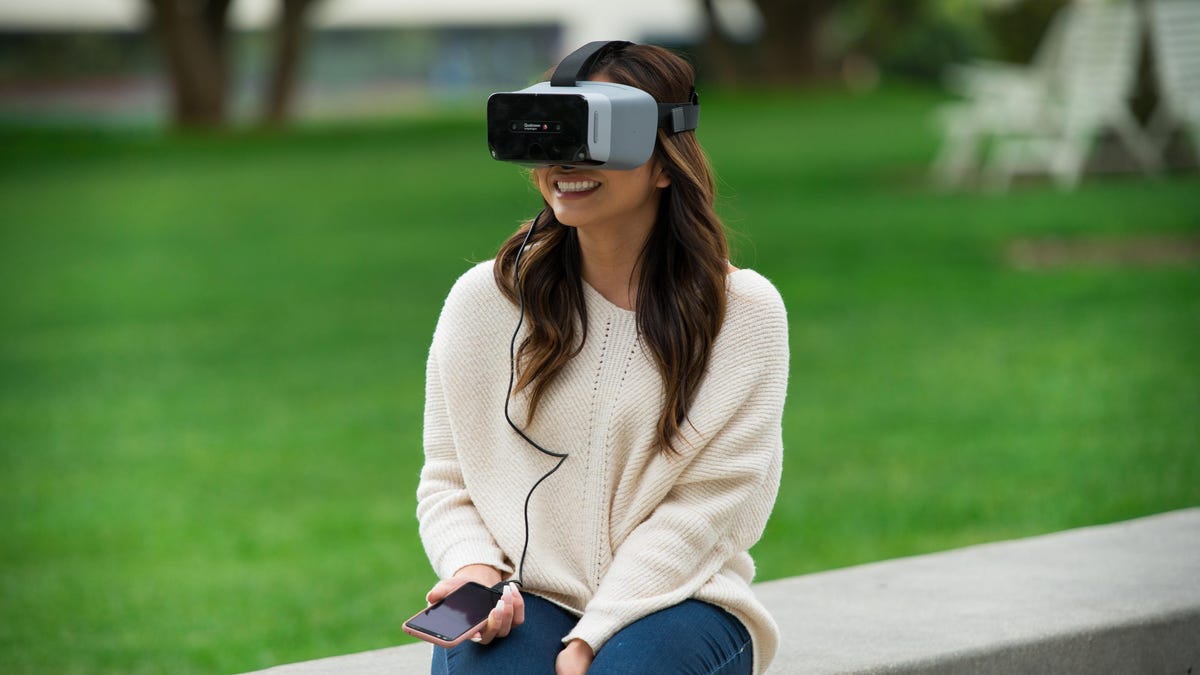Qualcomm's 5G phone-powered, eye-tracking VR/AR headsets are coming in 2020
The future of VR/AR will very likely be through your phone. The Smart Viewer is the reference design.

Qualcomm's phone-connected VR Smart Viewer: expect more headsets to run through the phone.
VR and AR headsets are going to be powered by phones, via USB-C, in the near future. At least, that's Qualcomm's plan. And those headsets could be a lot more capable than you might expect. Eye tracking, full 6DoF positional tracking like Oculus Quest and even controller-free hand gestures are part of the picture.
Qualcomm already announced USB-C compatible VR and AR headsets were coming earlier this year, but a new working prototype reference design announced today shows more of how these headsets will actually work.
The Qualcomm Snapdragon Smart Viewer Reference Design -- will connect to an approved range of 5G-enabled Snapdragon 855 phones using USB-C, but also has its own Snapdragon XR1 processor (same as the new Google Glass) to split processing. Imagine your phone does the VR heavy lifting, while the headset chip does some of the work, including controller tracking, eye tracking and headset positioning.
Qualcomm's head of XR, Hugo Swart, sees that marriage of phone and headset, and the split processing possibilities, as a way forward. Standalone VR headsets right now, like the Oculus Quest, do impressive things but rely on having powerful enough dedicated chips onboard. Qualcomm's split processing model could make smaller (or cheaper) headsets.
The headset reference design can work with full-motion 6DoF controllers like the Oculus Quest, or with controller-free hand tracking like the HoloLens, recognizing tap, zoom, pinch and scroll gestures. It has a 2K-per-eye display with 72Hz refresh rate, and two front cameras that can track full-motion controllers or hand gestures (the Oculus Quest uses four front cameras).
Eye tracking onboard
The Smart Viewer also has eye tracking built in, provided by Tobii. Qualcomm introduced eye tracking on mobile VR headset prototypes over a year ago, but it looks like this time, maybe, eye tracking could finally arrive in more products.
While the Smart Viewer connects with a phone (or a PC), it could also technically work on its own without a phone, should a manufacturer want to build storage onboard and have it work as a more basic VR-AR device. Qualcomm says the decision depends on whether someone would like standalone functions with a higher price and bigger size, or they'd prefer a slimmer, smartglass-like look.
Qualcomm's chips are increasingly in nearly every major AR and VR mobile headset on the market: Microsoft HoloLens, Oculus Quest, Vive Focus, Google Glass, and Google's standalone Daydream VR platform. That's why news of this reference design matters: Previous Qualcomm VR reference designs have led to hardware like the Oculus Go, Google's Lenovo Mirage Solo, HTC Vive Focus and Oculus Quest.
The Smart Viewer reference design, manufactured by GoerTek, will be sold to businesses interested in modifying or adapting the technology, and according to Qualcomm's Swart, it's intended to accelerate future VR and AR headsets to arrive faster. Swart doesn't think many of these headsets will come by 2019, but headsets based on this reference design and tech should definitely come in 2020.
Which means, along with 5G phones, we're going to likely see a lot of lower-cost, USB-C connected smartglasses and VR headsets coming, too.

